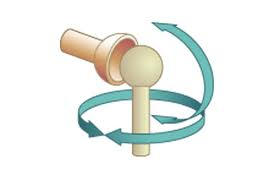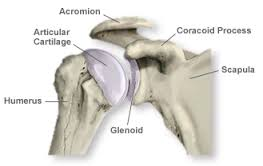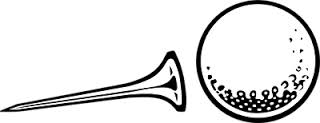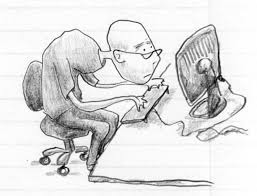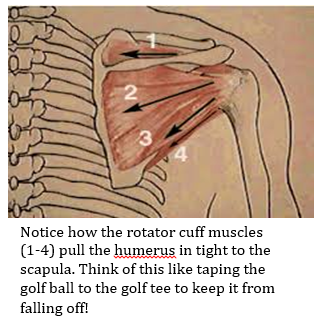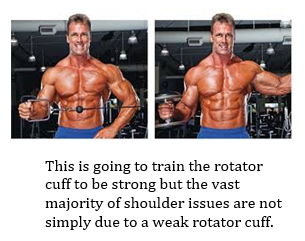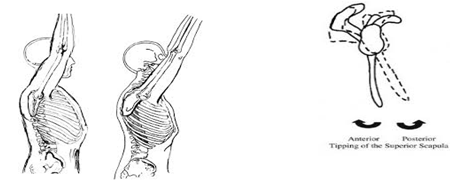In this article I’ll be discussing the importance and how to’s of maintaining healthy shoulders while exercising and in daily life. Following these few pointers will keep your shoulders healthy for years to come.
As a chiropractor and a strength coach, one of the most common things I see in both novice and experience lifters is a lack of proper shoulder motion/positioning during activities both in and out of the weight room. I believe that he biggest culprit here is the fact that the vast majority of working professionals spend their days staring at a computer screen and wreaking havoc on their joints. For starters, our joints are simply not meant to be held in one position for hours on end. And with regard to the shoulder, we often hold them in a position of anterior translation of the humeral head and anterior tilt of the scapula. Put more simply, our shoulders roll forward. Chronically putting the shoulders in this position leads to muscle imbalances and tightening of the posterior shoulder capsule that perpetuates this forward shoulder position and leads to a painful cycle of shoulder degeneration.
QUICK ANATOMY LESSON
Our shoulders are a ball and socket type joint. This means that one part of the joint is round while the other side is concave.
Now, our shoulders are going to be at their most efficient and injury free position when our joint surfaces are most congruent. This means that we have as much of the ball in contact with as much of the socket as possible. This allows for our shoulder to have the most support as we go through different movements. The issue here is that unlike the picture above, the shoulder is not a perfect ball and socket, it is much more like a golf ball on a tee. The head of the humerus (golf ball) is larger than the glenoid fossa (tee). Take a look:
This relationship between the scapula, where the glenoid is, and the humerus is the essence of what we are talking about here. These two things moving in concert is what provides shoulder stability. Without this stability we risk things like rotator cuff tear/injury, labral tears, frozen shoulder, and muscle imbalances. Here’s another analogy to help you understand how the shoulder moves. Think of how a seal at SeaWorld balances a ball on his nose. I know, just stay with me here. When that ball starts to roll one way or the other off of his nose, the seal must move his nose underneath the ball to assure that it doesn’t fall.
Just as the seal moves to keep the ball on his nose, we must move our scapulas to accommodate the changing position of the head of our humerus. This keeps as much of the ball touching as much of the socket as possible and provides us with a stable shoulder.
Sounds simple enough. The problem is that through our daily postures, we don’t always keep that golf ball right on top of the golf tee. We often let our shoulders roll forward as we reach out to type on the computer, do something on the phone, or anything else that causes us to reach out in front of us. The world around us is built so that everything we do requires us to push our heads forward and assume that all too familiar posture.
Ok, so we’ve spent all day in this posture that puts our shoulders at risk of degeneration and is going to make it so that by the time we are wanting to play catch the with grandkids, we can barely get that arm up to scratch the top of your head without pain. What to do about it? Go to the gym and get those shoulders strong! Good plan, but we have to make sure that we are training the shoulder properly.
I’LL JUST GO TO THE GYM AND MAKE MY SHOULDERS STRONGER
Most people go to the gym and do “shoulder exercises” that they think are making their shoulders stronger. What they are actually doing is adding fitness on top of dysfunction. They are making their condition worse by making themselves stronger in a compromised position. Often times while exercising, we fail to properly set up the shoulder before we start the exercise, which means that all you’re doing is perpetuating the problem. You’re making it so that the muscles around the shoulder are very good at holding that shoulder in the unstable position it started in. Good exercises can be done with the best of intentions, but most of the better known shoulder exercises do not address the issues that we discussed. It’s not as simple as making weak shoulder muscles strong. It’s an issue of motor control, or being able to move and adapt to situations.
The rotator cuff functions not only to rotate the shoulder internally and externally, but to ensure that the head of the humerus and glenoid maintain congruency, or to go back to our analogy, to ensure the golf ball stays on the tee. So training the rotator cuff the old fashioned way is again, adding strength on top of dysfunction. If you’re not putting the shoulder in a position of stability before doing the exercise, all you’re doing is setting up the shoulder for long-term dysfunction and injury.
HOW DOES THE SPINE FIT IN?
The last important piece to this multidimensional puzzle that is the shoulder, is the thoracic spine, or upper back. This is the part of your back that looks super rounded, or kyphotic, in the above pictures of the bad postures. Like I said before, we spend a lot of our day in that posture so naturally, going the opposite way is inevitably going to feel stiff. Think of how it would feel if you bent your index finger back a little bit and held it there for a few hours. Bending it forward after a while might feel stiff and painful. This is what happens in the thoracic spine and shoulder.
The importance of the thoracic spine is that it provides the platform where the scapula sits. Now lets remember, when the shoulder rotates up, the scapula must move under the shoulder to make sure that it stays stable, much like the seal with the ball on its nose. If the scapula is sitting on a surface that does not allow it to move upward, the shoulder will ultimately suffer. Extension of the upper thoracic spine is an absolute prerequisite to healthy and stable shoulders. Without it, we cannot properly tilt the scapula to ensure it moves with the head of the humerus.
To sum up, healthy shoulders are dependent on far more than stretching out tight muscles and strengthening “weak muscles.” The muscles the surround the shoulder joint must work in concert to ensure seamless motion of both the humerus and scapula to provide a stable shoulder and avoid degeneration and injury. Many shoulder ailments that “just come with age” can be rehabilitated and return you to that shoulder of yester-year. Regardless of weather you need to throw a baseball 100mph, play catch with the family, or simply reach up to put that bowl on the top shelf of the cupboard, unstable shoulders can prevent you from doing things you enjoy.
Although everyone’s shoulder is different and require their own specific rehabilitation plans, treatments are often a combination of loosening up and restoring extension the upper back, providing mobility to tight shoulders, and retraining the shoulder and scapula to move as a team. Even old rotator cuff tears can be rehabilitated and movement patterns restored. Our Doctors will be able to show you simple exercises once you are pain free to keep those shoulders healthy and progressing to full functionality.
The chiropractic physicians at Chicago Chiropractic & Sports Injury Centers will take you through a full movement evaluation to determine which of these components is missing from your rehabilitation plan and provide you with the treatments necessary to fully bulletproof your shoulders and get you back to moving pain free!
Author
Dr. Jeffrey Jones D.C., C.S.C.S.
Loop Chiropractic & Sports Injury Centers
